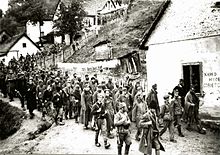Partisan–Chetnik War (1941–1945)
[1] Before the start of hostilities, the Partisans and Chetniks launched an armed uprising against Nazi-occupied Serbia after an incident in the town of Bela Crkva.
Just a day later, on the night of November 28, a Partisan commander named "Španac" was ambushed and killed by a Chetnik detachment under Vučka Ignjatović.
On the same day, Draža's men met with Jozef Matl and established contact with Nedić and the German Army.
Two days before the incident in Trešnjica, as a reprisal for the death of Španac (or just complications on the battlefield), Chetnik positions near Užice were attacked by Partisans.
[5] — Draža MihailovićAt 12 o'clock on 21 November, the ceasefire agreed upon by Chetnik and Partisan forces after the battle at Ravna Gora was enacted.
Nedić allied himself with Italian divisions, Muslim militias, and Sandžak Chetniks for a general offensive against the Partisans.
On February 9, the Partisans successfully maneuvered to Western Sandžak, suffering relatively few casualties and avoiding a major enemy offensive.
Major fighting began on the 10th when the Partisan Romanija Corps attacked Ustaša Home Guards in the village of Kuli.
The first major Partisan-Chetnik combat in Eastern Bosnia occurred on the 20th when the Partisans were attacked in the village of Vukosavci by Chetniks under the command of Dragoslav Račić.
In the village of Zakum near Rogatica, the Chetniks imprisoned the leaders of the Partisan Romanija Corps, who were executed the following day.
They first intended to attack Vlasnica, where the so-called "King of Romanija," Jezdimir Dangić, resided, and then Han Pijesak, where the Ustaše were based.
This is evident in Radoslav Đurišić's report to Draža Mihajlović: "Some commanders and officers, as soon as they learned about the presence of Partisans, asked their men if they would fight against them.
Chetnik commander Radoslav Đurić described the takeover of Vlasnica: "In Vlasenica, they immediately announced that they had liberated it from collaborators.
"The Chetniks found themselves outnumbered and unpopular, with the Muslim population unwilling to fight the Partisans and many officers abandoning their positions.
However, your letters indicate that, from a political perspective, the movement had negative aspects because it was carried out when Chetnik units were fighting the Ustaše near Han Pijesak.
In our opinion, the negative aspect of your movement towards Vlasenica can only be addressed by decisively organizing the liquidation of the Ustaše and Croats (homeguards) at Han Pijesak, with the participation of some of our brigade units as needed.
When we sent you directives strongly opposing your temporary movement towards Vlasenica, we thought it was absolutely wrong to position our forces between the Ustaše and Chetniks.
We wanted to wait and see how things would develop, given the failed negotiations between the Croats and Serbs, under German pressure, regarding the cession of 17 districts to Serbia.
On April 8, the final phase of the Battle of Eastern Bosnia began with the start of Operation Trio, during which the Chetniks collaborated with the Italians, Germans, and Ustaše.
The Chetniks who refused collaboration had heavy battles around Drinjače with the Black Legion and were ultimately defeated around the Drina by April 25.
The Germans and Ustaše captured the city of Rogatica after the successful transfer of Partisan troops to the Italian zone of the NDH and Northern Montenegro.

